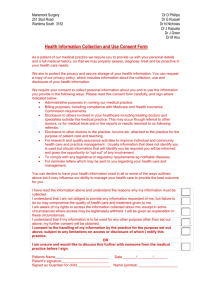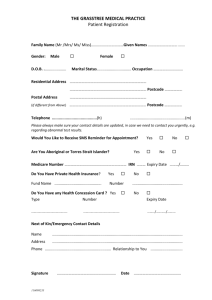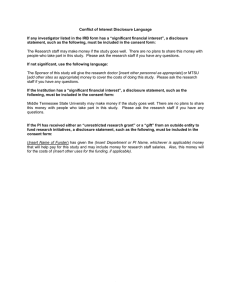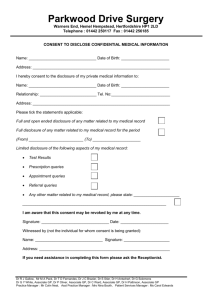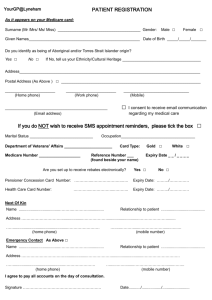+ 2 (,1 1/,1(
advertisement
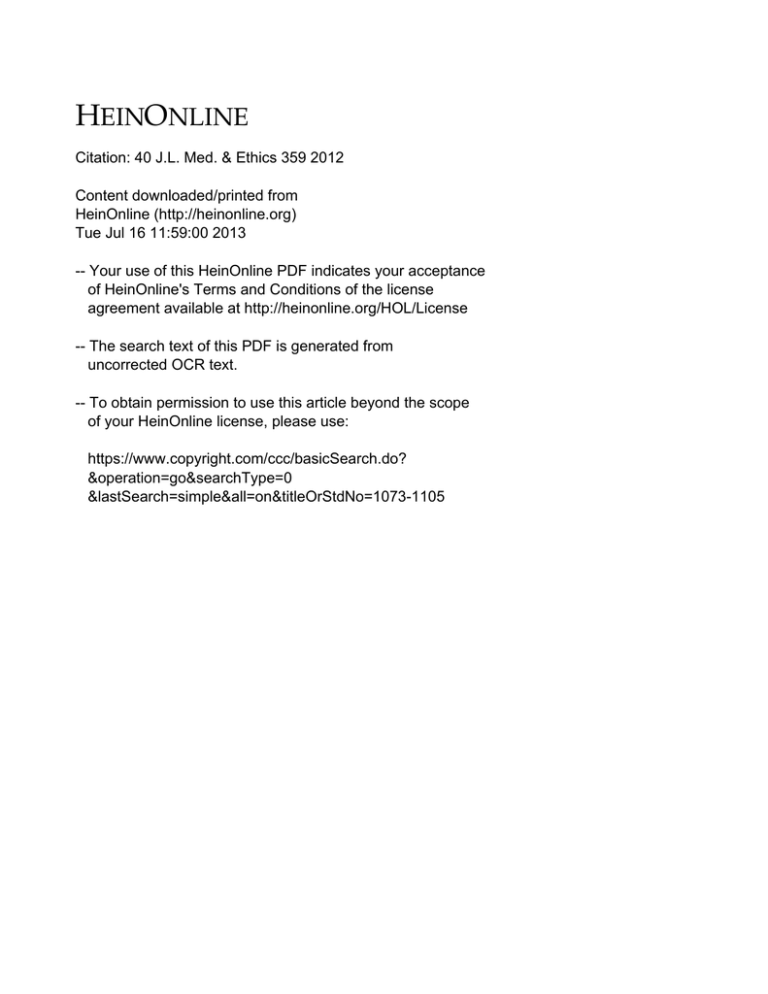
+(,121/,1( Citation: 40 J.L. Med. & Ethics 359 2012 Content downloaded/printed from HeinOnline (http://heinonline.org) Tue Jul 16 11:59:00 2013 -- Your use of this HeinOnline PDF indicates your acceptance of HeinOnline's Terms and Conditions of the license agreement available at http://heinonline.org/HOL/License -- The search text of this PDF is generated from uncorrected OCR text. -- To obtain permission to use this article beyond the scope of your HeinOnline license, please use: https://www.copyright.com/ccc/basicSearch.do? &operation=go&searchType=0 &lastSearch=simple&all=on&titleOrStdNo=1073-1105 Attendin to Patients Need n tbe nfnoried Consent Process &l Siegal,RichardJ. Bo [ntroduction: Impediments to Informed Consent [n an explicit attempt to reduce physi s< bec hea a ft infco the inft ter iStics,6 h~ ISE cel ibodi the s shoi be >f decisions that relate to their bodies Fh< corollary obligat ion of physicians - to tor ase sent procec However, there a deliberation the n when hysi alicy i7 health ns ofter ssft tel D LL.B., S.J.D., Virginia School Of zlth Law and Bioel r Researcher at the d. Richard J. Bo addressed e is another Dfthe inft consent do( Ssuccessf bst e very he ick of pati< flow of infc th e infc have Physicians vb te< ent prior to 0 trea Thatever the sta: rd the LL.B., Srofessor of Medic nd L( >unda, Sc 1P ychia ry and d :-Policy, and B ,id Pu 5lic Polie lum, M. Ty, Medi if these isclosure of specifie info ed by the hysi asonab1 S ome states have adlopted th of stand ning tlhe infor: that Eionshoul be by tors ("what wo their >able patie: to make a deci vhile others to kn ("wha EdardIfc to the asonable physi cian" stain h ible physi Isi ift sO sul nd ab1 perso ta me af Dnot.9 The acceptet ft r this information ractical g physi of facili by thei to live up to Si info iake educated decis isclosi 5E aft to patient self-deter Gil Sil and other beh ial" decision-making? h~ave cast doubt Iapacity to understand e disclosed inft nake choices that acct tely reflect thei he Sf :ilitate patient au tonomy - is reflected it have been crea ted to implement conofrelevant to compreh< ssary health literacy a )hysicians' disclosures, h~ car( lbaum 5,andPaul S.A; tion, the re, 4e the informa be in a posi S. id Law, and the ychiatryin theD ,rsity andNew H :St EGHT TO ibl1 is rel >f informati sclosi is that given inforr it will be ab1 rantto her ch iake , she Eh ify e E hat to h if her decisi when pre., Eh astive infoi fer to this assistance rei tei inform s - i. bE )rofessional <c itidence in tf >ersonag that is relevan cess. As a r( 11t, some phi ft ffvaueo tconfet 5 les the Irature o heloft bombardin, their patieni Fhis is on Sreasoi ation ("overl "), which sti obst wh ch f gei tine "informed asent"i atient's neecd or despairirn valueinofmtin the et cess rather tha t. fp At fen earacterize ng such an <( -:ensive discle dictb fity andoshaki ifortunately, th, -rocess of inf close some r aimal amoui sto n-making is n<( Dften re fE-actice. Instea( thei elves to liabi axposing oeif information a rb for reasons we dl ribe bE s retrospecti, ngful dialogu to be insufficient. Unc rtainty is als hl be tween doctors sh. initoo often bee n A by dis placed by a sty )fr 'esentations rbid g and signing for *M. erns -ders,5concur -reatments,I Df symptoms, degri Ofmedical lite hc lake The Ritual of InformedConsent stan dard disclosure (Suc is tnose re( dby th ifo th Most agree that the commonplace rituial of informe 0nsent - focused as it is on the pr esentation an has many flaws.12Viewe s igning of a consent form ffrom the patient's perspective, what sh(ould be an ite tive, personalized process of receiving and absorbin nformation and seeking clarification oir further infor nation has become standardized an d inflexible, a hysicians attempt to comply with a du ity to inform a,,1 ible" r ininer. As a resul-t s< -inforr ie(d, while otherrs be from i rhcat is importan be te diffEreint than what a them (w]hich easonable pati to0nt k 3ble to ercise a ri ght not to kno .One might sa ponse, IS iat the int(erests of both )arties - phys 1patients - have to be t Lken into accoiunt in fori ing rules for informatic a disclosure. ASrequirerr for in alized or "subjI ed disclost ephysicians w tho woul, 3ictical wa )f tbility for faili to avoicd vhat inforl tion , -now. Ind( 5i for ju subj hE is y on in of the able When the problem ais viewed in thus way, ized disclosure migh,t be seen as a logical ft Lst lardf the law's effort to formu late a predictable rul the current approaclh has by no means elii amatect the risk of physician liab ility for failure to obta i informed consent. To the con atrary, many physicik is are still instates uncertain what is e xpected of them, eve .1 that accept the "reas onable physician" stal dard. Even when standardized disclosures have bee i endorsed by professional bod lies or risk managem courts have occasio nally ruled that the 1 fail- entitled to other inft ure to disclose inforr in those cases amoui consent, thereby cre O >fa about t E patLient's wish mportantly, ns of in 1sent Dspect, w b to obtain infe are mao :come has al d. A vh ha to 0der ascer )f sp h re altered the patient's decision, t1 1t for physic -iansto counter pat 1ients would h ave chosen a differer if nly the infor mation had been ava juries, like e,,ver,yone else, are influe "hindsight bias""- i.e., the tendent t since a risk 1 the patient w sition of liabi consecluence to laintiffs to 0 a given p to a fa onstruct ith rejected -ethat foci for infori ation in fi of disclosi st uate 0applicable profeassional associc .ons) e time of the rn lical teraction. sum, obtainir the ttient's inft hE ended to beco zet an eth in which physi ,ians are obey legal to inft ee of uncertain cer ("be ucope your rhich nt"), and ofter acting deferE y,and >f infoi ,nts lack conti 1 over the f leaving them ift both for be relative to thei .decisional new ds and of receivin nf information t1 an they need i r desire. This su . f unwanted infe rmation can di tract them fromI evant issues, 16 leave them urn luly worried aboxu iscule risks,7 nd possibly le, id to decisions c( to their real -*A fshes. This is all the more dist -bi >f because preoc cupation with the "legal sufficit the disclosurE 'makes physi -ianscvnical abc th whole exercise (often awkwar cons( a hi quate inform( r the unwante this stage, it -ificationwou is making it d'if- nts' claims th course of actic Able. Judges ai ced by a stroi to believe th terialized, if told ab it it in advant Idhave chosen differi -itly.19 The imp Tin these cases has si fificant financi both enages award( the subsequemiums. rs msurance, ssed in this .m of inforr OURNALOf vhethE Sie al.ABonnie, andAi 1hi L's vhi Is( hysicians. between the flow of inft ift tection for :er rs, the physi he consent f of hysi :es isclosure pr rivey the re ended course of tr ssion and hand thE significant tei th< staff membE Ter the form. What we are pro compatible with - and sh ove the consequences of - a >s- >f seauences. this or r whic ft ssesf SE st >a st chieving Personali ed Disclosure e aim to shift genuine ontrol over the informationa ocess to patients, an I to facilitate a personalize( ocess by overcoming both the information asym bl th relevance problem. By per ceiving inforthe processoffonalizing SE nation, our proposal woul rts to specify heir desire for information his approach rests on re iffe n their level of risk aversit to sug Aintroduced to <( 1sent to medical ss or fi if d written consent. Howe, to be useful in this contex be modifie< te< >f h :a: kkey feature of <( it from patient ,nee for informa his is to ulqn h for specificity. ar's seat, rather S1l how much to certed effort to >f ir overall prefsponsibility of Iting in either disclosure (oft if Lion of. elves in medical infe cal f3 Yal defe o her (oft( ter rs to s of self-efficacy, anc to Rec zing that sr Lh Eeimportant decisions, fa nt a fully in( 11 bE ab1 e to imph iffe nees may be embedc1 st cultural inf lu cess imme tely, we sugge >syncratt r ences (be th, -based).21 The S eddbsr the goal of o ans of whi nsent sh be sh tped to reflect law of inforr dslsr opte -ts can be h ieved. ther thai them.22 C 011these variati, sider, for exa ges tgeI r sitional St( p Forward the of a proposei si :a Se first1: stageffraof i 7e-The th written desc: tered model of inft isclosure is,, -I come or, to t] >h dshift ster rni Zal sicians shoul, d not be reqt by o >f patic ste< d for inforrr .e patient and shoul if IS( formula for obt, d from the ] him- or herself. The take their ted to signal his or E rdesire for inforbe approach ,are proposi ght be described, ir lude to the disclosur process. It might i on demand" (IOD) shorthan ft rm. as "infor: >fwalking through be helpful to consi The fund: tients should be able There passengers self-idenl ify their status by se the aisle through if which th ev -pass: reen (no th is :es a%,,ge sigmti nust be paid). (carrying items on which customs as and speo ;arclmg the ways n mong physi Asi tional phase Similarly, patients during this sent is integrate( vhich the foa ility of obi I for informabe to pronounceI te i aisle (basic inf< s offered such hysi >ss the nature >f procedure/tre the reasons it arse of ter can return to being perff rmed, when thE iscl oSu: befc bE Lea to th fe EGHT TO fl 'slifE blue aisle (where mo iding major/significa information is risks of the p:i >SE ,nt defined by severil and frequency tbout alternat aisle (extensii ve info )rmation is p items that onliy a sm all number of Fb relevant). Standardized, Stratification cof will require dilffE medical procE might choose. ing task, it sh< the material ir ic ing consent ft roposea isclosure t stanaaraize bl te contel ipproach -for each Dl itinuity with exist eflect what mos t patients probab1 that can be testLed). One temn on the list of disclos ures (alternatives seems specially th(orny. As indica ted in Table 1, th "basic" lisclosure ( the green aisle I)would include on of the pr(oposed procedu re, the reason for i I consequences, but would not ini zer entation of alte rnatives to the ret be described in th cedure, which sclosure (the bl 1S1 atients who ch< >Sa rst (green) tl e informati< would be asked if if so, Ibe describe about alternatives a >ffers Prompting this opti teE ren if if tence of alternative LU hensioi nuatibi he WO~L11 personanizei process can bE made by th these th Disclost eaccording be embodi 1in physici written or her materisent form: is well. Of of disclosur o rse ibout a top disclosure for the " ha ns the nhysi she has selected. When th must provide accurate infor to the question, irrespective of thl SE Ut11U hysician's stan to advise ab si apatient should be told this a :hoice to as k for more (red) c his for each "ai that th Fugh this is a ittedly a ch 10t be too bi e to extract from existation mneach categ Seen as a collaboi ve effort to be involved 11 stakeholders sho Lgmedical professic to 0sprovide itient advocates to ure accessi- isl ible patient" star ssentially th efault, bu uld be legally sensible to make th patient regan are binding - ST h being retrot has stated his fe :es and th taken place he informed ci s failed to provide hi Ifc h hat his pers tHe cal it claim im retrospect version is different fr lm that sign choice for information disc' >sure he ha Df risl< f procedure/ I. Basic description of alternatives t 2. Major/significant risks of proposed about thE treatment and alternatives, defined by severity and frequency procedur 2. ExtensivE being recommended swithout treatment af ces if h th bv 1. ExtensivE tient can resume ife activitie about alt :ivE Extensive into about possibl ife abe Irnatives ves the "right ifil be the Mil :he risks of trc Scontent of thi tible with nbli idard or th abli thcit are designed ze liability exp< cl OURNAL O cive IC Siegal. Bonnie. andAl s. It bears nsent transe ag both par itional excha phasis, thou; 3h, ess should thE ,while pro urrent infc b1 fr be person surance t1 ,the patiel ie interact of switchi th 'sob1 as a physi informatii ible if ("Just tell me wha h to t's 1 se chooses to oposed tre; this ch tails the r( comfort th to n Stage oft sun atient's desig tionship b tage 2: Fully Individualized Disclosure dvances in information t(echnology will eventually f acilitate lEm a highly personal ized solution to the prob- nsent disclosure throug software.2 For Example, once a physicia of individualizing co to an agen ir nteractive ority to con h as proposed a particular c ourse of treatment to the has explained th ft ys terms, the physie the believe thE confront th with makin ide informa iseauences )al cos1 lst is se bi ther tha pose with p ossib1 hysicia: tai ations for th ted td positive S aw is 'fe physi Eto dc al rtant ste] is Lai ift face if 5sclosur< rst ffers ife rmed consel lnt's right to ving such wa to delegate decisi ces of and the alter hvsician. to the p to sent to it's de: to the conset th th h If the p o Secist ter L's ft by gate esponsibili iscomfort og should be or, if th eclines, to gent. We ackn< vledge that has ecognized a Eaditionally isclosure of infc nation. Bui b,ased on the ide that some choosE t to J be rbi o set of in A ike to ofRight to Be Info? od t be permissible t oE Sthe right to be in for hear that stuff. Ji )? Although stron tE the sides. sbth N be' 1,such no positioy Tor by radiotherapy, with sin ilar survi il rates 90%), but with very differer t impact on the t's life. it choose to del- si iacha. to tel LOuue pm cates pers is in tryngeal cancer, which ,an be tr tted by L's bl to Isle is so burden is shift rhere the cht that the phy sician of I 1a CD, flash drive bsi abc link toa ter- ed info nd altei present purposes, we >se ),C1 hE atient physicall vill lose have babies) - sed to p ved by s( isclos ure of which ca In ais le. We are also i to includ agent designated by th Patient or acting on behalf af Lpatient lacking decisi of al ternatives to the tE nimum disclosi capacity) has Eal the cogni- ability to navigate he way through an interactive Ehine nroram. The t hing (software) program iduals to specify their level thosE [GHT TO )finter formation, but would pro- vide hypertext link,els of sp at that would enable tients to obi ainforn demand (IOD), bc d on their : ividual Much as museum sitors who it an au can elect whether Fhear more tail abc number of topics to the Fated:hibitioi th oFwould hav ,similar >f viewing, patients t flexibility and cont Use of informaation technology trol over the flow, of information as opportunities to recview the informat a substal comprehension. Additionally, there tmine the applicati< Af develo exa to opportunity technologies to the understanding sid,e of A software prograrm can be written in suc after completing tthe educational miodul associateo with the disclosur re, patients could takel a mini-tes (readability at an, 8th grade level) t( o ass .sswhethe they had sufficien-t understanding of th procedur (and possibly the r -isks, benefits, and; alter iatives). If, e patient consistentl ly "fails" such a tes-t, it I aight signo a need for legallyE effective decision-r maki g authorit to be assumed by an adeauately inf(orm( J surrogat decision maker. ;h suc h After the patient ized disclosure proicess, til ip-t" of the patient's mation be( avail,able to both cauld inforr for requests Ln. th( and A patient p( the Lephysi a-nsona.l interaction with the physician regar ig any aans,-wered questions can then enssue, fo1 red by th e formal indication of consent. Th iis appi ch is in te nde d to preserve atient- phaysic- 1ian relationthe personal qualitty of th ,rves ar sei also it but ship, aportai ntlega'tl purpose. If n action afFter tthe fact that ii a claims leg a patient "I should have rec -eived litional Sil nfor mation," the ill show wheth( er his ( lafim iis backed by w script h ictual b(ehavior. If it sh ows thcit he ddid not open cl :ified hyl links Ir tobthe risks Fertext thrat mater lized whim giver nity to do so, t he misma -h betwe en his informatio and his : ces would s hat the info stLrong infe mnce that the wTas not re 1vant to hir and (if unrebutted >f s ever the c usal link ne 3sary fo: .cein informed con S( litigati< i Lappears that expi -e for informed co wever, a fully deve modality for achie sort is probably st be r 0equired assure t] to to r educe the risk that I info 0rmation, op and to tel rses of will need to be available to allow physsici to ine-t une" the disclosures, and the substant ial ba rs to use IT in medical practice will have to be In the meantime, however, the "trainsi tio I si so Dn" outlined above - admittedly a sn ie that 0reflects a serious effort to achiev Tegreater bi t control over the flow of information diuring the at process - can be implemented. Lisms Addr essing Possible Objections The p ersonalized process enables the patient Lto iden- tify an d select the informational sets she car res about (for el' vcample, inevitable consequences as op-)posed to poten tial risks, frequent side effects as op posed to more, remote chances of complications), and t to receive answ( rs to her individual concerns. Unde r a welldesig ned computer-assisted process, the "relevance probl em" is solved completely by the patie ,nt's continuir g opportunity to demand and probe t he availto ascertain its applicabili ity to her able i formation situat it i proposal, is solved lb categ< ,tely. Thus, the content of eac hcatep of information (mainly about risks or altern iatives) ft every proceduri,ewould have to be formulatLed for hree aisles. Ske ht claim that,, particularly during the tr harbors the stage, what w( e ft urrecting or rei nforcing (as many feel poten it ney medical patern alism - i.e., by allowing pa als to s elect options sh iort of "full disclosure," we wi II be encc iraging them to rely on the judgment of theair plhysic ans by renderi,.ng them incapable of indep ende .ntchoice. This c -zern is exacerbated by -seeking behavior will the pirospeact that informat be str ongl y related to soci s tatus and education: patie nts w,ho are relatively le ducated, uninformed, unsop)histii.cated, poor, socia Llly vulnerable, and Sby tlhe medical systerm are likely5 ,to rece ant of informati(on, while patients th yree of health liteeracy and socio-ect hF >f osi vill seek and rec-eive the highest 1I afo )n. these concerns vTery seriously, but v >ffer Fses. First, our proposal offers abetter ,tion irrent ritualized ppractice which is no aally promote choi ce. Moreover, it do( not ients wi Fth soft at are a ee disparities in praiLctice any worse thce they ad inf ormation techn ad, to the contrarry, provides a platft i for >f 5 closing the health literacy gCap in the long run t. ugh xpers onalized disclosi ifo . technolog.6 11 advances i rs away. Researc d, bro carram is user-frie cts for patient E werme. y, doubts abonF ul ted transforma it overlook t that h >f )f already oco rst th acquisition of i -al info h, I- mation by powered health e ou i OURNAL O Siegal. Bonnie. andAl f s consumers of othe rs so entify herefo atients are frequently f information they ne< nteraction that we eny Lively to specify the inft Second, we envision levelovping the standal cess for ag both should I disclosui )bout professi or about bridging thE chs should be Standardized disclos fr< high( ducators, and ot Yher stakeholders. Ther at educational task to be isno material ison foi andertaken so ical profession or heald by the .s. Such effort wouh are organizal b whether our pro sal ne or-patient relati ishis. eserve patients' opportt of "ais les" as they proceed ar Frcess with multile b that reac tF cai >ssibility th so we suspect th the numbe will not be large would encou e attentio to this possible 2ffect as thesi ipproache Lre tested. Of cc thei Fllinganxiety, some 3,way of corn d exc- rse, as Fht to obt As o0 Will personalized d isclosure sent litigat for elimi ft if tation of a rst ing disclosi n some states to" 1of disclosure is wh t is possible tb demented by t] refinemen t of existin and respec aft -mation. Moreover, ft five lecact )sal could be a i te inft :edly be a ch yal octrine that h ge, since it would refr Isi Fh EGHT TO genuine preferences. Sf-1 hysi the ing depersonalization of n( the stress we eed for a personal n )nship, the Fning consent f 1prior to formally sig rs its should be having t'Fe h th th ed position, to ft vhat is importa afa being flooded af mation. accept this approach >f a protective star Dfinformationa Lag to ana to assui to alter their ch At the choice the concerr st ', The Path Ahead :se the risk-a, rse default pos ' choices information co rid medical infc is also importaifferences bearii hat icare decisions in parti >sure in dis- rba ractice se- se :ar provide reli- lost flec at ing st re that the bodies of kn differ ent categories of standa tinue to reflect updated sciei mratic n in an accessible fash . to col duct research on indivi rl ac Pt Pa m a bi b is lisclosures a rsonalizes d sire for information ger ntal process able demonstratis th 2r point of concern c<( 1d be that p b( defeated, rather tha empowered by the erst ized approach - i.e., tlhey might bEe overvhel even in the transitior I stage by ha .ving to :hoice about the level :f informatio n that t. Implementation of a omouter-bas ed dis- informa he high, hvpert rfe avoid the effort i d professional commit :f our sugges tempts to g ierate better n for nPatiei as physici F, concerns must bE h collaborations vh 1c1 >f are whethe isensus-b c phases of implementa tinct areas of sur, with the Dur approach hoices rather counteract concerns ment. We thereft that allows the g ase t Dftel As ( f failing to seek ter-assisted modality fc ibts abc Iinforr legal effet Given th S. [us "4malpractice irefoi ach eving the ,galcha es necessary to m Sake:h pro osal wort -ay have rnore sanguine fu ture anti -ipatedat rst sight. rhether such effor ts sh be i indertake will del nd on "proof of ugh subsi tial beh oral research. Ou r modest is to lay d vn a nev ,aradigm of informyaation on 2Ad to em, wer patients, enha nce legal ,ertainty, and o hieve gr(eat er congruence betLween the lients waant and the informa tion they In o m tIto is ]peeceive. ,ssible tI hat this approach c(ould also promote more neaning]ful patient-physiciain iinteracLions mnmany cases, a de.,sir-able outcome that has been lifficult to ach: ve by ot1 , means. for Shar Law & r redicine 32, no. 4 (2001 S. T. Bog irdus, E. Holmboe, ant Possibilii es in Talking about M (1999): 1 )37-1041. P. H. Scl uck, "Rethinking Infoi nal 103, 10. 3 (1994): 899-959; Informed Consent i reUniversity Press, 20( Ashe v 3adiation Oncology As 1999). For ex ple, Wilson-Toby v. L N.Y.S. 633 (2010). (Althoug ag," American , 29-501, at 493'.Jekel, "Perils, I 1 Risk," JAL4 Consent," Yale 3Manson and oethics (Cambri at 27. 9 S.W.3d 19 ag 13. 14. 39 cin, 72 A.D. 3c ib1 Ref abl1 S. ab1 S. AT-i ,35 334 St Sc 43-45 S. K. Si 3 997): Surgeons, JAM4 St d 34 >3 St R ites yal Si 553-559. kd-L 19E .S. S. JAMA 274, no 995 Slovic, C. K. I and Decision 1 407-413. B. J. Powers, Patient Read JAMA 304, no der, "How She sions?"JAMA 83, H. Roth, "6Tov sent: A Revies Law Review 2 1983): 265-346. B. McNeil, S. I aker, H. Sox Jr., . Shaked, lates for St irs," Ne w E 332-2837. ( S. iS( 3 S3 )S and C. E. St s in Medical 2390-2391 ;A. Meisela of Informed IStudies," A Sa nees for Alterna gulation," Journalof He -3 (2003): 387-419; S. J is of Negligence and th havior 20, no. 5 (1996): H ine 306, no. 21 1982): 1259rd E. Peters, "B( nees," JAMA 3(C ,and R. J. Boni Siegal, N. Si, Action Probl in Public Healt] Ar Health 99, n, (2009): 1583-1 S. K. Sivalingai M. B. Rotht Joelson, and ceptions of tl for Stable Cc ronary Disc ATi 9. 307-313. -d M. K. St ,d Client De )0, no. 3 (19 )9): 195-19' American Surg< ~, HE 0 3 ,tern Bic idMA 2 11, no. S. 3, 5 Sc )9) Social Sc 53- ~, 23. OURNAL O es about Inforny 1-246; J. A. Carr he Navajo Reser 1995): 826-929. S A IAl I St ib< . Se t3-. 79 Si rSi /31 rnet," .063- 34 31 1H Se . St Health Ab le Sc 31, no. 4, Su Hanusc 3. 28.Se 3 S Impact Regarding "'Journal S //www.scil 04331> (1a ent: Tech So Scientific A? M. Sr Stter: Pre Americaj 7): S47-S5 S. 3 29.G. Si( .Zi turE "Heo EGHT TO 333, an,
